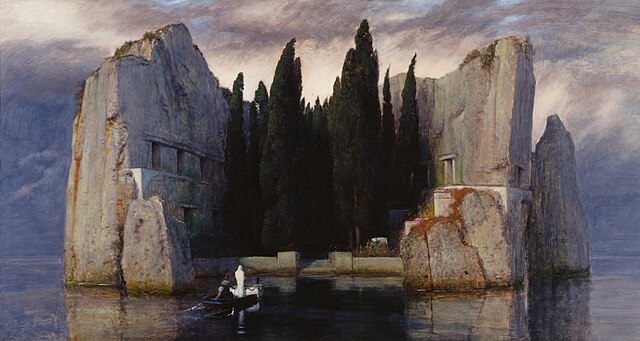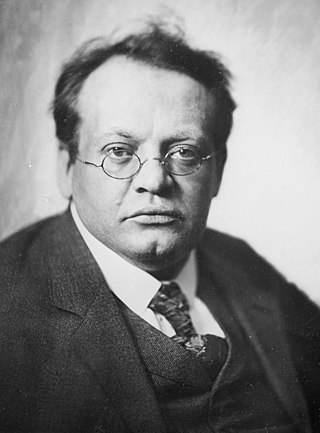Top Qs
Timeline
Chat
Perspective
Vier Tondichtungen nach A. Böcklin
1913 composition in four parts for orchestra by Max Reger From Wikipedia, the free encyclopedia
Remove ads
Vier Tondichtungen nach A. Böcklin (Four tone poems after Arnold Böcklin), Op. 128, is a composition in four parts for orchestra by Max Reger, based on four paintings by Arnold Böcklin, including Die Toteninsel (Isle of the Dead). He composed them in Meiningen in 1913.
Remove ads
Background and history
While tone poems were a common genre around 1900, including many works by Richard Strauss, Reger typically wrote more abstract music.[1] He described his Eine romantische Suite, Op. 125, and the tone poems after Böcklin as "Ausflug in das Gebiet der Programmusik" (Excursion in the realm of program music).[2]
Reger composed the four tone poems in Meiningen from end of May to July 1913, after planning it from October 1912. He dedicated the work to Julius Buths. The score and parts were published by Bote & Bock in September 1913. Reger conducted the first performance in Essen on 12 October that year, with the Städtisches Orchester (municipal orchestra).[3]
Remove ads
Structure and scoring
Summarize
Perspective
The four parts are in contrasting tempo, slow–fast–slow–fast. Both slow movements, 1 and 3, are marked Molto sostenuto (aber nie schleppend) (but never dragging), both fast movements Vivace.
The work is scored for a symphonic orchestra of three flutes (including (piccolo), two oboes (including Cor Anglais), two clarinets, two bassoons, contrabassoon, four horns, three trumpets, three trombones, tuba, harp, three timpani and more percussion, solo-violin, strings (divisi in I).[3] The pieces can be played individually or as "a quasi-symphony".[4]
Der geigende Eremit

Der geigende Eremit (The Hermit Fiddler,[5] literally: The hermit playing violin) is based on a painting Der Einsiedler (The Hermit) that Böcklin made in Florence in 1884.[6] A solo violin is contrasted by a group of strings playing con sordino and another group playing not muted.[1] The "ethereal violin"[5] has been compared to Ralph Vaughan Williams' The Lark Ascending, composed in 1914.[5]
Klaus Uwe Ludwig wrote an arrangement of the movement for viola and organ, which was published by Breitkopf.[7]
Im Spiel der Wellen

Im Spiel der Wellen (literally: In the play of the waves) is based on a painting Im Spiel der Wellen (Playing in the Waves) that Böcklin made in 1883. Like the painting, the music evokes the shimmering foam of surf in sunlight, and the play of naiads and Triton.[2] A reviewer compares the movement to Debussy's La mer written a few years earlier, noting that "Reger pursued the flamboyant realm of mythical creatures".[5] Both works have a similar "sparkling orchestral character".[4]
Die Toteninsel

Die Toteninsel (Isle of the Dead) is based on a painting of the same name that Böcklin made in five different versions between 1880 and 1886.[8][9] The painting has been regarded Böcklin's most famous work, with a title not by Böcklin himself, but the art dealer Fritz Gurlitt.[9] Thomas Mann characterized the painting as expressing Sympathie mit dem Tode (sympathy with death), typical for the fin de siècle. A composition based on the painting by Andreas Hallén appeared in 1897, others followed, including a piece of the same title by Serge Rachmaninoff in 1909.[9] Reger writes "long-held but shifting sonorities", using the orchestra like an organ.[5]
Max Beckschäfer arranged Reger's movement for organ in 1984.[10] He played it first at the Marktkirche Wiesbaden in 1985, along with the organ part of his arrangement of Reger's Hebbel Requiem.[11]
Bacchanal

Bacchanal is based on a painting Bacchantenfest (Feast of the Bacchants), painted around 1856. It may recall the "folly of earlier orgiastic times", or the longing of an older person to still be part of them.[5] Reger, who called his own experience "Sturm und Trank" (storm and drink), as pun on "Sturm und Drang", used conterpoint, harmonic development and refined instrumentation to achieve a dazzling painting in sound.[2]
Remove ads
Later performance
The work was performed in the official opening concert of the Reger-Jahr (Reger year) 2016 in Leipzig, where Reger died in 1916, played by the orchestra of the Musikhochschule Leipzig.[12]
References
External links
Wikiwand - on
Seamless Wikipedia browsing. On steroids.
Remove ads





